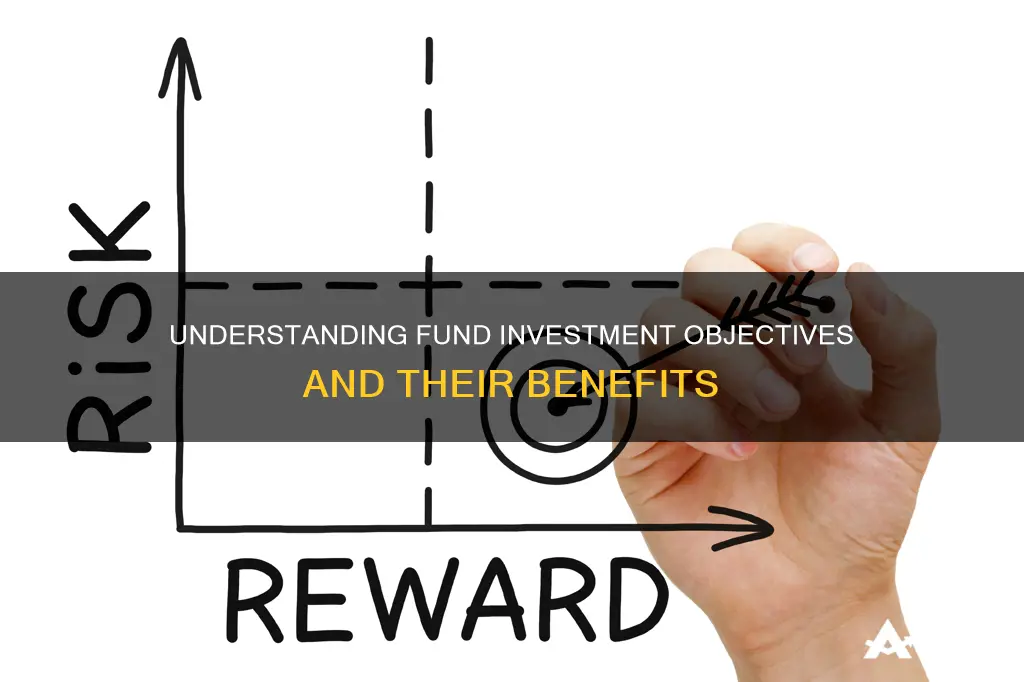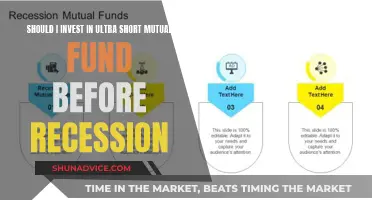
An investment objective is a statement that outlines what an investor hopes to achieve with their investment portfolio. This could include generating income, preserving capital, or growing assets. Investment objectives can be short-term or long-term, and they can be specific to an individual investor or a group of investors.
The investment objective is a critical component of the investment process as it provides the framework within which investment decisions are made and strategies implemented.
An investor's risk tolerance and time horizon help determine their investment objective.
| Characteristics | Values |
|---|---|
| Definition | A statement outlining what an investor hopes to achieve with their investment portfolio |
| Timeframe | Short-term or long-term |
| Applicability | Individual investor or a group of investors |
| Techniques | Income, growth and income, growth, or trading |
| Factors | Time horizon, risk tolerance, financial situation, goals, investment budget |
| Types | Capital appreciation, income generation, risk reduction, diversification |
| Importance | Provides the framework for the investment decision and strategy |
| Considerations | Realistic and achievable, risk tolerance, time horizon, review and update |

Income generation
To achieve this objective, investors can consider investing in assets that offer consistent cash flow, such as dividend-paying stocks or bonds. Dividend-paying stocks are shares of companies that distribute a portion of their profits to shareholders as dividends. Bonds, on the other hand, are fixed-income securities that pay periodic interest to bondholders. By investing in these types of assets, individuals can receive payments at regular intervals, which can supplement their income or provide financial support during retirement.
It is important for income-focused investors to carefully assess their income needs and choose investments that align with their requirements. Additionally, they should be mindful of the risks associated with income-generating investments, as higher-yielding assets may come with a higher level of risk. To mitigate this risk, investors can diversify their portfolio across different income-generating assets, creating a more stable income stream.
In summary, income generation is a critical investment objective, particularly for retirees or individuals seeking regular income from their investments. By investing in dividend-paying stocks, bonds, or other income-generating assets, investors can achieve their income goals while managing risk through diversification. Balancing income generation with growth objectives allows investors to meet their current income needs while also building wealth over time.
Tax-Efficient Fund Investing: Strategies for Smart Returns
You may want to see also

Risk reduction
Diversification
Diversification is a fundamental risk reduction strategy. It involves spreading investments across different asset classes, industries, sectors, and regions. By diversifying, investors can reduce the impact of single-security risk, where the performance of an investment portfolio relies solely on the success of one company. Diversification helps to offset potential losses by ensuring that if one investment is falling, another may be rising.
Risk Tolerance and Time Horizon
Understanding an individual's risk tolerance and time horizon is essential for effective risk reduction. Risk tolerance refers to the degree of risk an investor is willing to accept, and it influences the types of investments they choose. For example, a conservative investor with a low-risk tolerance may focus on income-generating investments like dividends and bonds, while an aggressive investor with a high-risk tolerance may opt for a portfolio with a higher proportion of stocks and trading opportunities. Time horizon also plays a role in risk reduction, as younger investors with longer time horizons may be more willing to take on riskier investments.
Asset Allocation
Asset allocation involves distributing investments across different asset classes, such as stocks, bonds, alternative investments, and cash. It is important to consider risk tolerance and time horizon when determining the appropriate asset allocation. For instance, an investor pursuing growth may decide to allocate 80% of their assets to stocks and 20% to bonds, accepting more market risk to achieve their financial goals.
Dollar-Cost Averaging
Dollar-cost averaging is a strategy where investors commit to investing a fixed amount of money into the same investment vehicle at regular intervals, regardless of market performance. This approach helps to reduce risk by naturally buying more shares when the market is low and fewer shares when the market is high. It also helps investors avoid making emotional investment decisions.
Safe and Secure Investments
While there is no such thing as a completely risk-free investment, some options come close. These include government-issued securities in stable economic systems, such as US-issued bonds, and AAA-rated corporate bonds from large, stable companies. These investments offer a pre-set rate of interest and a very low risk of default.
Risk Management Strategies
Individuals, financial advisors, and companies can develop risk management strategies to help mitigate risks. This includes understanding the different types of risk, such as systematic risk (affecting the entire market) and unsystematic risk (affecting specific industries or companies), and using tools like standard deviation, beta, Value at Risk (VaR), and the Capital Asset Pricing Model (CAPM) to quantify and analyse risk.
In conclusion, risk reduction is a crucial aspect of investment planning. By incorporating diversification, considering risk tolerance and time horizon, employing dollar-cost averaging, seeking safe and secure investments, and developing comprehensive risk management strategies, investors can effectively reduce volatility and protect their portfolios from potential losses.
Raising Capital for Investment Funds: Strategies for Success
You may want to see also

Diversification
The most common way to diversify is to invest in different asset classes such as stocks, bonds, real estate, or cryptocurrency. Stocks represent the most aggressive portion of a portfolio and provide the opportunity for higher growth over the long term. However, this greater potential for growth carries greater risk, particularly in the short term. Bonds are generally considered to be less volatile than stocks and can act as a cushion against the unpredictable ups and downs of the stock market.
Risk is often present at a company-specific level. Risk specific to a company can occur from legislation, acts of nature, or consumer preference. For example, the departure of a revolutionary leader from a company can negatively affect its performance. Therefore, it is important to diversify by acquiring shares of different companies within the same industry.
Different countries operating with different monetary policies will provide different opportunities and risk levels. For instance, a legislative change to US corporate tax rates could negatively impact all entities within the US. For this reason, consider broadening your portfolio to include companies and holdings across different physical locations.
When considering investments, think about the time frame in which they operate. For instance, a long-term bond often has a higher rate of return due to higher inherent risk, while a short-term investment is more liquid and yields less. In general, assets with longer time frames carry more risk but may deliver higher returns to compensate for that risk.
Bond Funds: Risky Business, Not Worth Your Investment
You may want to see also

Capital appreciation
A capital appreciation fund is a fund that attempts to increase asset value primarily through investments in high-growth and value stocks. These funds may also be called aggressive growth funds, capital opportunity funds, or capital gain funds. They typically appeal to aggressive investors and carry higher risks but offer higher-than-average returns.
Mutual Funds: A Smart Investment Strategy?
You may want to see also

Long-term growth
Time Horizon
Long-term investing typically involves holding investments for a duration of five to ten years or longer. This extended time horizon allows investors to ride out short-term market fluctuations and focus on the potential for higher returns over time. It's important to note that long-term investments don't necessarily imply maintaining high-risk positions throughout the entire holding period. As investors approach retirement age or their financial goals, they may gradually reduce their portfolio risk.
Risk and Volatility
Diversification
Diversification is a crucial aspect of long-term investing. By spreading investments across multiple asset classes, sectors, and industries, investors can reduce the overall risk of their portfolio. Diversification helps protect against significant losses in any single investment and can provide a more stable foundation for long-term growth. It's important to note that diversification does not guarantee against losses but can help mitigate the impact of market volatility.
Cost Savings and Tax Advantages
Long-term investing strategies, such as buy-and-hold and dollar-cost averaging, can offer cost savings by reducing trading commissions and other transaction costs associated with frequent buying and selling. Additionally, in certain jurisdictions like the United States, long-term capital gains may be taxed at preferential rates compared to short-term gains, providing further financial benefits to long-term investors.
Compounding Returns
Compounding is a powerful advantage of long-term investing. By reinvesting dividends and interest, investors can accelerate their wealth accumulation. Over time, the returns generated by their investments can compound, leading to exponential growth in their portfolio value. This effect is particularly pronounced when investors consistently reinvest their gains over an extended period.
In summary, long-term growth as a fund investment objective emphasises maximising returns over a period of five to ten years or more. This strategy entails a long-term perspective, acceptance of higher risk and volatility, diversification across asset classes, and a focus on compounding returns. By adopting this approach, investors seek to build substantial wealth over time, benefiting from the effects of compounding and long-term capital appreciation.
A Beginner's Guide to Exchange-Traded Funds Investing
You may want to see also
Frequently asked questions
An investment objective is a statement outlining what an investor hopes to achieve with their investment portfolio. This could include generating income, preserving capital, or growing assets.
Common investment objectives include capital appreciation, income generation, risk reduction, and diversification.
When choosing an investment objective, consider your goals and time frame. Are you seeking long-term wealth growth or short-term income generation? You should also assess your risk tolerance and budget.
Investment objectives provide a framework for making investment decisions and implementing strategies. They ensure that the investment strategy aligns with the investor's goals and help financial advisors determine the best course of action.
You can work with a financial advisor to assess your goals and create a plan, or you can conduct your own research to gain a better understanding of your investment options before defining your objectives.







